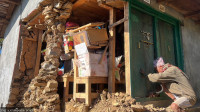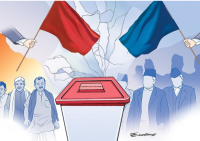Columns
Border dispute reaches new heights
The geopolitical environment post-Covid-19 must be well analysed and evaluated, considering that Sino-US and Sino-Indo relations are not the same as before..jpg&w=900&height=601)
Binoj Basnyat
The source of the Kali/Mahakali River constitutes the most integral part of the bi-lateral, track-one debate over the disputed area of Limpiyadhura, Kalapani and Lipulekh between India and Nepal. The current administration led by Prime Minister Oli endorsed, distributed and initiated the process of amending the constitutional provisions of the updated political map including the disputed area in the north-western corner of the country. The disputed area is acknowledged to have strategic value for tourism, trade and transit and water; and is militarily vital for both China and India.
On a more macro level, the South Asian region, customarily under Indian political and security influence, is visibly more confrontational and disputed than before; and the foreign policy of these nations seems to be in disarray. Nepal has been waiting for a diplomatic dialogue for the last six months since the ruling Nepal Communist Party sent a diplomatic note of displeasure to the Indian Ministry of External Affairs subsequent to India’s publication of a political map officially accepting the state of Jammu and Kashmir and the disputed area of Kalapani last November.
Road inauguration
The foreign minister of Nepal called the Indian ambassador to his office to give him an objection letter after the inauguration of a road in the disputed territory, the construction of which began in 2008. The 80 km Lipulekh road through the Himalayan pass, which is the shortest route between New Delhi and Kailash Manasarovar, was inaugurated on May 8.
The Sugauli Treaty of 1816 that ended the Anglo-Nepal war states that east of the Mahakali River is Nepal. Statements issued by the British Survey of India on February 1, 1827, and April 24, 1856, show the ‘Area Kalapani’ within Nepal and the Kali River as the border with its source being Limpiyadhura. In 1981, a joint Technical Level Nepal-India Boundary Committee delineated 98 percent of the 1,800 km open border except for Kalapani at the Nepal-China-India tri-junction and Susta in southern Nepal. The map was submitted for ratification in 2007 but it did not happen due to Nepal’s stance of settling all border disputes including Kalapani and Susta. The Mahakali Treaty showing the river’s source in the Kalapani area, the first bilateral water treaty between Nepal and India, has not been implemented even after more than two decades.
Relations between Nepal and British India were governed by the 1816 Treaty of Sugauli and the 1923 Treaty of Perpetual Peace and Friendship. Prime Minister Mohan Shumsher, the last Rana ruler of Nepal, and newly independent India signed the 1950 India-Nepal Treaty of Peace and Friendship for a closer strategic, commercial and cultural relationship.
The Rana rulers feared that China would support the Communist Party of Nepal and sponsor a communist revolution that would overthrow their autocratic regime. The tyrannical rule was replaced by democracy three months after the signing of the treaty even as India sought to strengthen its ‘Himalayan frontier’ by creating an alliance on defence and foreign affairs with the Rana rulers, Sikkim and Bhutan. An Indian military training team was given access to Nepal for training and capacity development of the Nepali Army in February 1952, with 17 posts being set up along the Nepal-China border. The team returned in January 1970.
Nepal and India have a special relationship. The political relationship has its ups and downs. Two observations are clearly visible. The first is the admirable and favourable relationship that both countries cherish after a major political altercation and the interests of India, the political parties and the government congregate. The 1990 restoration of democracy with an official blockade by India, king Gyanendra’s takeover to deal with the Maoist menace and the 12-point agreement that took place in Delhi followed by the peace process to bring the Maoists into the democratic framework, are examples of three political shifts in recent history that have elevated the relationship. The relationship soured and reached a low when India articulated its reservation over the 2015 Constitution with an unofficial blockade and again with the current question of border encroachment.
The second is the rise of China’s influence leading to geopolitical and geo-economic stimulus in the South Asian region. The militarisation of the Himalayan region can be an example of China’s interests being more political in defending the province of Xinjiang, Tibet and Yunnan. China may not be concerned about Maoism and communism nowadays, but it thinks more about Tibet to gesture to India that it too can offer the expenditure on a long-term assurance policy. Nepal needs to balance its foreign policy with changing realignments, as geopolitical strategic trends in South Asia are not what they used to be. South Asia is proceeding towards newer alignments. The current geopolitical realities will have a direct impact on maintaining political trust in border management with immediate neighbours.
Things to do
The geopolitical and geo-economic environment of South Asia post-Covid-19 must be well analysed and evaluated for future action considering that Sino-US and Sino-Indo relations are not the same as before. The northern border with China along the Himalaya will continue to be of concern to both China and India. Here, the traditional mechanism of foreign policy management may not prevail. Irrational moves may put the Non-Alignment Movement and the Bangladesh, Bhutan, India and Nepal Motor Vehicles Agreement on life supports, much like the South Asian Association for Regional Cooperation.
Three things must be done by taking India and China on board for immediate and long-term border management. Create a separate border security force, revamp and review the roles of strategic organisations for national security, and establish a system for border management. As for Nepal-India matters, start bilateral talks between the foreign secretaries to lay the groundwork and prepare for a political agreement, bring out the Eminent Persons’ Group report, and revive the 1981 Joint Technical Level Nepal-India Boundary Committee report taken over by the Boundary Working Group that was established in 2014. Nepal and China should also revisit the 1961 border agreement for an effective border management system as the trends of strategic communication networks, like the Koshi, Gandaki and Karnali corridors, is coming up. The only way forward is through diplomatic dialogue.
***
What do you think?
Dear reader, we’d like to hear from you. We regularly publish letters to the editor on contemporary issues or direct responses to something the Post has recently published. Please send your letters to [email protected] with "Letter to the Editor" in the subject line. Please include your name, location, and a contact address so one of our editors can reach out to you.




 19.12°C Kathmandu
19.12°C Kathmandu















